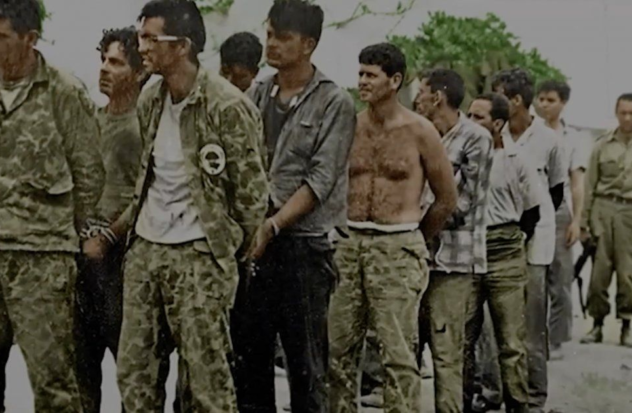The incursion of April 17, 1961 was an episode that marked the history of Cuba and shook relations with the United States.
What happened, where and when?
In April 1961, the Brigade 2506, supported by the CIA, landed on the island with the aim of overthrowing Fidel Castro’s regime. This event, known as the invasion of Bay of Pigs or Playa Girón, still sparks debate about its causes, consequences and the role of foreign powers.
The Cold War context significantly influenced the planning and execution of this invasion. The United States, fearful of growing communist power in the Western Hemisphere and concerned about the alliance between Cuba and the Soviet Unionsaw in the Brigade 2506 an opportunity to destabilize Castro’s government. The operation was conceived as part of the policy of “containment” of communist expansion.
According to data from the JFK Library, José Miró Cardona He led the anti-Castro Cuban exiles in the United States. As a former member of Castro’s government, he had been the head of the Cuban Revolutionary Council, a committee of exiles, so Cardona was prepared to assume the provisional presidency of Cuba if the invasion was successful.
Launched from Guatemala, the attack was flawed almost from the beginning. Despite the government’s efforts to keep the invasion plans secret, information leaked to Cuban exiles in Miami. Through Cuban intelligence, in October 1960 Fidel Castro He learned about the guerrilla training camps in Guatemala. The components of Brigade 2506 that landed at the Bay of Pigs were defeated in two days by the Cuban armed forces under the direct command of Castro.
Faced with the invasion, Castro ordered approximately 20,000 soldiers to advance toward the beach, and the Cuban air force continued to control the skies. Some exiles escaped to sea, while the others were killed or detained and imprisoned by Castro’s forces. Almost 1,200 members of the Brigade 2506 They surrendered and more than 100 died.
Who made up Brigade 2506?
Around 1,400 Cuban exiles volunteered to secretly enter the island and begin an offensive with a view to stopping the advance of the Castro regime.
These young people had a stage of training military with the support of the CIA in different camps, and they occupied various positions in the attack teams, in addition to using weapons and military equipment provided by the United States.
Although it failed, the plan was staggered and sought to stop the counterattack: several paratroopers were launched before the invasion with the aim of interrupting transportation and repelling the Cuban forces. Simultaneously, a smaller force would land on the east coast of Cuba to create confusion.
What was the result of the Bay of Pigs invasion?
Although his aim was to disembark in Cuba and provoke a popular rebellion against Fidel Castro’s regime, the operation did not have the expected success. Cuban forces, led by Fidel Castro, responded with ferocity and determination. Numerical superiority and popular support were key factors in the defeat of the invaders. In less than 72 hours, the raid was put down and Brigade 2506 surrendered.
The consequences of the invasion were multiple, but above all it made the Castro regime present itself as a leader capable of resisting external aggression.
What effects did it have on US politics?
On the other hand, the defeat in Bay of Pigs It embarrassed the administration of John F. Kennedy, who had inherited the plan from his predecessor, Dwight D. Eisenhower, generating internal and external criticism of American foreign policy. So he was a turning point in the history of Cuba, the United States and the Cold War.
The invasion of Bay of Pigs also had repercussions in Latin America and the rest of the world. He reinforced anti-American rhetoric in the region and contributed to the rise of leftist movements that sought to distance themselves from the influence of the United States.
As point According to the Office of the Historian of the US State Department, the failed invasion strengthened the position of the Castro administration, which proceeded to openly proclaim its intention to adopt socialism and strengthen ties with the Soviet Union. It also led to a reevaluation of Cuba policy by the Kennedy administration. The President established a committee under former Army Chief of Staff General Maxwell Taylor and Attorney General Robert Kennedy to examine the causes of the defeat at the Bay of Pigs.
Although it was a political failure for the United States and generated criticism of the CIA and the Kennedy administration. However, it also inspired a renewed commitment to the fight against communism in Latin America and beyond.
What becomes of them today?
With their faces weathered by time, the former members of Brigade 2506 maintain a constant that lasts: mutual respect, camaraderie and the joviality with which they interact among friends. It is common to see them meeting at the Brigade 2506 Museum, in Miami, and participating in exile activities in favor of the freedom of Cuba.
Many, in addition to the feat of 1961, continued in the line of service and wear the merit medals that they have earned with honor in the US Army.
Its mission is to transmit to new generations those values that were shattered in Cuban society since 1959, so that the search for freedom and democracy does not cease on an island that has been under dictatorship for 65 years.
In that sense, and as Iliana Lavastida indicated, “the most valuable thing about the legacy of these men is their example and it is very timely today, for the times that Cuba and Latin America live in, that the young people of this time know about these young people who with their “They bravely exposed everything to save their country.”
Although 63 years have passed, the smiles and emotions are on the surface in these heroes when they remember their desire for freedom in an invasion that, if possible, they would do again.
DIARIO LAS AMERICAS The documentary series premiered in 2021 Testamentan audiovisual project about the Bay of Pigs invasion and Brigade 2506 that seeks to tell, beyond the recounting of historical events per se, the human angle of the protagonists, and thus preserve their valuable testimonies.
Source: U.S. Naval Institute / United States Department of State / CIA / Defense Technical Information Center / JFK Library / Harvard / Britannica




